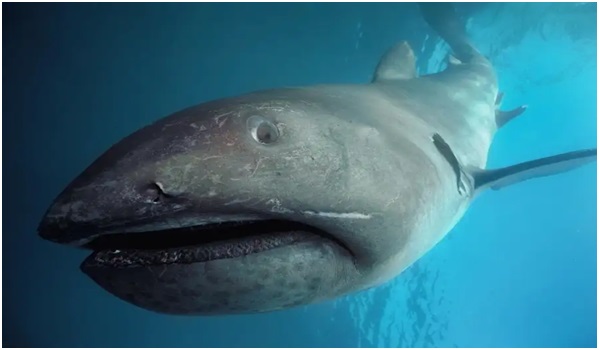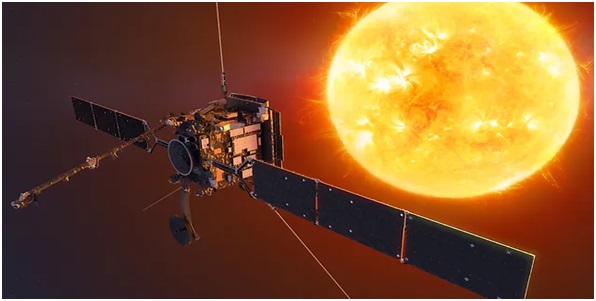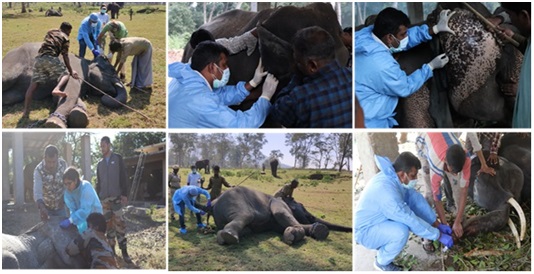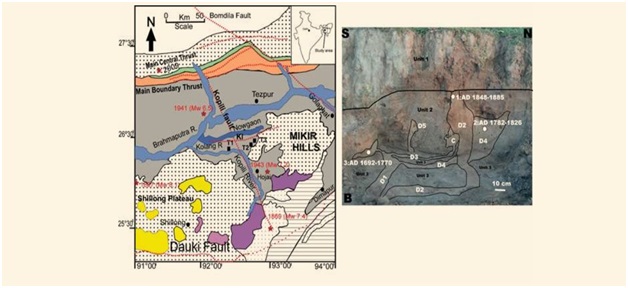Mystery of megamouth shark solved after one washes up in Philippines (Business Insider)

- 06 Dec 2023
Why is it in the News?
Recently a dead 18-foot megamouth shark that washed up on the beach in the Philippines was pregnant, confirming for the first time that these mysterious creatures give birth to live young.
About Megamouth Shark:
- Researchers have found Megamouth sharks to be particularly elusive.
- Since their discovery in 1976, there have been fewer than 300 sightings of these deep-sea sharks.
- Uncovering fewer than 150 specimens, scientists have identified them as the smallest of three species of filtering sharks.
- Their scientific name is Megachasma pelagios.
- Similar to their relatives, the basking sharks, Megamouth sharks feed on krill suspended in seawater, utilizing their oversized mouths to sieve their food.
- Although most sightings have occurred near the Philippines and Taiwan, these sharks have been observed around the world.
- These sharks are found in deep, warm oceanic water and inhabit the Atlantic, Indian, and Pacific oceans.
- Characterized by their substantial size, Megamouth Sharks can reach weights of up to 2700 pounds (1215 kg) and lengths ranging from 425 to 515 cm. Females are generally larger than males.
- Easily recognizable by their large, soft head and anteriorly positioned mouth, their colouration varies from grey to bluish-black above and pale grey below.
- They possess small, hooked teeth along both top and bottom jaws.
- As filter feeders, they swim with their mouths continuously wide open, filtering their preferred planktonic prey.
- The inside of their mouths is equipped with light-producing organs that may attract pelagic crustaceans and other potential prey.
- On the conservation front, the Megamouth Shark is listed as "Least Concern" on the IUCN Red List.
Closest-ever Sun photo captured by Solar Orbiter (India Today)

- 06 Dec 2023
Why is it in the News?
The European Space Agency's Solar Orbiter has captured the most detailed image of the Sun's full disc and outer atmosphere, the corona, to date.
What is the Solar Orbiter?
- Solar Orbiter is a Sun-observing satellite, equipped with 10 state-of-the-art science instruments, that aims to provide unprecedented insights into the workings of the Sun.
- It intends to conduct an in-depth study of both the Sun and the inner heliosphere, exploring the uncharted regions closest to our Solar System.
- A collaboration between the European Space Agency (ESA) and NASA, it represents the most intricate scientific laboratory ever dispatched to study the Sun.
- Distinguished by its capability to capture images of the Sun from a closer vantage point than any preceding spacecraft, it also marks the first exploration of the Sun's previously uncharted polar regions.
- Launched on February 10, 2020, the mission unveiled its initial images in June of the same year.
- Following gravitational assist manoeuvres at Earth and Venus, it commenced full science operations in December 2021.
- Solar Orbiter actively orbits the Sun in an elliptical trajectory, with its closest point, the perihelion, located approximately 25 million miles (40 million kilometres) from the Sun—closer than the orbit of Mercury.
- In terms of instrumentation, it actively carries six remote-sensing instruments for observing the Sun and the solar corona, along with four in-situ instruments for measuring the solar wind, energetic particles, and electromagnetic fields.
- The mission actively aims to continue its scientific operations until at least 2027.
Panchayat Development Index (PIB)

- 06 Dec 2023
Why is it in the News?
The Union Minister of State for Panchayati Raj recently informed Lok Sabha about the Panchayat Development Index.
About the Panchayat Development Index:
- The Panchayat Development Index serves as a comprehensive and versatile metric designed to actively evaluate the holistic advancement, efficacy, and ongoing progress of panchayats.
- This index actively considers a spectrum of socio-economic indicators and parameters, offering an actively nuanced understanding of the well-being and developmental status of local communities within the panchayat's jurisdiction.
- Objectives: The primary objective is to actively play a pivotal role in assessing performance and progress towards actively achieving Sustainable Development Goals at the grassroots level.
- An active component of this initiative is the Local Indicators Framework, which encompasses nine key themes for actively localising Sustainable Development Goals.
- These themes actively encompass creating poverty-free and thriving livelihoods, ensuring health and actively child-friendly environments, actively promoting water sufficiency, actively fostering clean and green spaces, actively developing self-sufficient infrastructure, actively establishing socially just and secure communities, actively promoting good governance, and actively creating women-friendly villages.
How Ranking Works?
- Ranks within the index are actively assigned based on scores, actively categorising panchayats into four grades.
- Those actively scoring below 40 percent are actively classified as Grade D,
- 40-60 percent as Grade C,
- 60-75 percent as Grade B
- 75-90 percent as Category A
- and those actively surpassing 90 percent are actively designated as A+.
- Significance of this Index: The significance of this index lies in its ability to actively offer valuable insights into areas requiring attention and improvement within rural areas under panchayat jurisdiction.
- It actively aids in identifying disparities, gauging the achievement of development goals, and actively crafting targeted policies and interventions to elevate the overall well-being and quality of life in rural communities.
Elephant Endotheliotropic Herpesvirus (EEHV) (DST Gov)

- 06 Dec 2023
Why is it in the News?
The study by ICAR-Indian Veterinary Research Institute (ICAR-IVRI), Izatnagar, Bareilly has found the exact status of EEHV and its subtypes circulating among the Asian elephant population in India.
What is Elephant Endotheliotropic Herpesvirus (EEHV)?
- Elephant endotheliotropic herpesvirus (EEHV) is responsible for one of the most devastating viral infectious diseases in elephants worldwide, especially young Asian elephants.
- EEHV is a double-stranded DNA virus that is classified in the family Herpesviridae.
- The mortality rate is very high (70-85%) and death occurs within a short period (2-4 days).
- In India, the incidence of EEHV-HD was first reported in 1997.
- 9 of 15 potential cases were confirmed from Southern India in wild free-ranging calves in Kerala, Karnataka, Tamil Nadu forest reserves, and Madras Zoo.
- Transmission of the disease: EEHV is mostly spread through mucosal secretions which include:
- Saliva, Breast milk, Nasal secretions, Trunk to trunk contacts etc
- The disease can only affect elephants and is not infectious to humans or other animals.
- Symptoms: Some elephants show symptoms such as reduced appetite, nasal discharge and swollen glands.
- Treatment: Treatment involves a combination of strategies such as antiviral therapy, aggressive fluid therapy to counter haemorrhaging, immuno-stimulant drugs like selenium and Vitamins C and E, as well as antipyretics and analgesics to manage fever.
- It's important to note that there is no definitive cure for herpesviruses in animals or humans since these viruses typically enter a latent state.
Scientists uncover seismic clues in Kopili Fault zone, advancing earthquake preparedness (PIB)

- 06 Dec 2023
Why is it in the News?
Recently, scientists at the Indian Institute of Geomagnetism (IIG) have detected seismogenic liquefaction characteristics within the dynamically active Kopili Fault (KF) zone.
About Kopili Fault Zone:
- The Kopili Fault extends from the western part of Manipur up to the tri-junction of Bhutan, Arunachal Pradesh and Assam.
- It covers a distance of about 400 km and is closer to the Himalayan Frontal Thrust.
- The Kopili fault bisects the Meghalaya Plateau and isolates the Mishmi block from the main part of the plateau.
- The Kopili fault is almost passing through the Kopili River.
- The river Kopili rises in the North Cachar Hills District in Borail Range at an altitude of 1525 meters.
- From a field study, it is observed that the Kopili Fault region is moving in the northeast direction at an average velocity of 28.397N mm/yr and 40.227E mm/yr.
- This region is characterized by heightened seismic activity, classified within the most critical Seismic Hazard Zone V.
- The geological dynamics are attributed to collisional tectonics, where the Indian Plate subducts beneath the Eurasian Plate.
- The fault itself is a transpressional fracture, producing dextral strike-slip earthquakes in the lower crust.
- The Kopili fault zone, a tectonic depression filled by the alluvium of the Kopili River and its tributaries, has experienced numerous seismic events, notable among them being the 1869 earthquake (magnitude 7.8) and the 1943 earthquake (magnitude 7.3).
